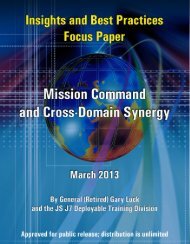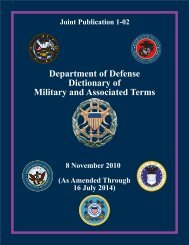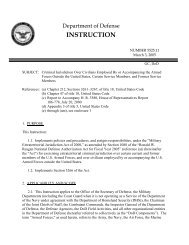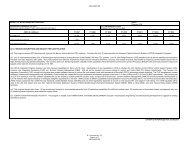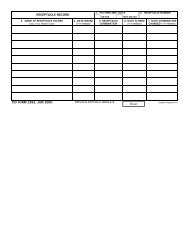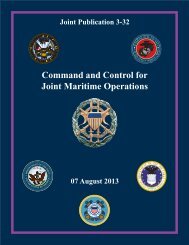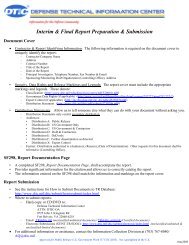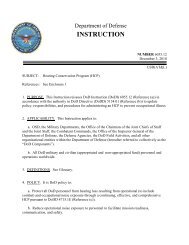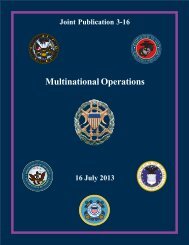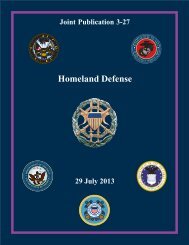JP 1, Doctrine for the Armed Forces of the United States - Defense ...
JP 1, Doctrine for the Armed Forces of the United States - Defense ...
JP 1, Doctrine for the Armed Forces of the United States - Defense ...
You also want an ePaper? Increase the reach of your titles
YUMPU automatically turns print PDFs into web optimized ePapers that Google loves.
Chapter VI<br />
(6) The JTS supports DOD implementation <strong>of</strong> <strong>the</strong> joint learning continuum by<br />
providing <strong>the</strong> construct to plan and implement a comprehensive organizational program that<br />
may include elements <strong>of</strong> training (individual, staff, and collective), education, selfdevelopment,<br />
and experience to achieve mission capability. This process establishes <strong>the</strong><br />
linkage between <strong>the</strong> NMS and CCMD missions, operational plans, and tasks inherent in<br />
those plans and joint training. The final product is a CCDR JMETL and <strong>the</strong> CSA AMETL<br />
that reflects and consolidates <strong>the</strong> mission capability requirements <strong>of</strong> <strong>the</strong> CCMD into a single<br />
list <strong>of</strong> tasks, conditions, standards, responsible individuals, and organizations.<br />
(7) The JTS represents a series <strong>of</strong> logical and repeatable processes that are intended<br />
to continuously improve joint readiness. Used correctly, <strong>the</strong> system helps CCDRs,<br />
subordinate joint <strong>for</strong>ce, functional, or Service commanders, o<strong>the</strong>r senior commanders, and<br />
CSA directors to train more efficiently and identify areas <strong>for</strong> improvement. Effectively<br />
using <strong>the</strong> processes within <strong>the</strong> JTS better enables commanders to assess <strong>the</strong> level <strong>of</strong> training<br />
readiness in <strong>the</strong>ir commands and <strong>the</strong>n make in<strong>for</strong>med judgments on <strong>the</strong>ir ability to per<strong>for</strong>m<br />
assigned missions under unified CCMD.<br />
b. Influence <strong>of</strong> Joint Training<br />
(1) The Universal Joint Task List (UJTL) is a doctrine-based construct detailing a<br />
universe <strong>of</strong> military tasks linked to specific conditions and standards. The UJTL provides a<br />
standardized tool to support <strong>the</strong> planning, execution, evaluation, and assessment <strong>of</strong> joint<br />
training. The UJTL <strong>of</strong>fers a library <strong>of</strong> mission tasks <strong>for</strong> <strong>the</strong> development <strong>of</strong><br />
JMETLs/AMETLs and readiness reporting as well as defining capability requirements <strong>for</strong><br />
readiness reporting, systems acquisition, and contingency operations planning.<br />
(2) The ultimate objective <strong>of</strong> <strong>the</strong> joint learning continuum is <strong>the</strong> provision <strong>of</strong><br />
mission-ready individuals and collective entities. Broadly, <strong>the</strong> missions to be accomplished<br />
are articulated in <strong>the</strong> war plans <strong>of</strong> <strong>the</strong> CCDRs.<br />
For fur<strong>the</strong>r guidance on joint training, refer to CJCSI 3500.01G, Joint Training Policy and<br />
Guidance <strong>for</strong> <strong>the</strong> <strong>Armed</strong> <strong>Forces</strong> <strong>of</strong> <strong>the</strong> <strong>United</strong> <strong>States</strong>.<br />
7. Lessons Learned<br />
a. The joint lessons learned component <strong>of</strong> joint <strong>for</strong>ce development entails collecting<br />
observations, analyzing <strong>the</strong>m, and taking <strong>the</strong> necessary steps to turn <strong>the</strong>m into “learned<br />
lessons”—changes in behavior that improve <strong>the</strong> mission ready capabilities <strong>of</strong> <strong>the</strong> joint <strong>for</strong>ce.<br />
The conduct <strong>of</strong> joint operations provides <strong>the</strong> truest test <strong>of</strong> joint doctrine, joint education, and<br />
joint training. Accordingly, it is crucially important to observe keenly <strong>the</strong> conduct <strong>of</strong> joint<br />
operations, as well as <strong>the</strong> execution <strong>of</strong> each part <strong>of</strong> <strong>the</strong> joint <strong>for</strong>ce development process, in<br />
order to continuously identify and assess <strong>the</strong> strengths and weaknesses <strong>of</strong> joint doctrine, joint<br />
education, and joint training as well as strategy, policy, materiel, and supporting military<br />
systems. Properly assessed, <strong>the</strong>se positive and negative observations help senior leaders<br />
identify and fix problems, rein<strong>for</strong>ce success, and inside <strong>the</strong> joint <strong>for</strong>ce development<br />
perspective, adjust <strong>the</strong> azimuth and interaction <strong>of</strong> <strong>the</strong> various lines <strong>of</strong> ef<strong>for</strong>t.<br />
VI-8 <strong>JP</strong> 1



